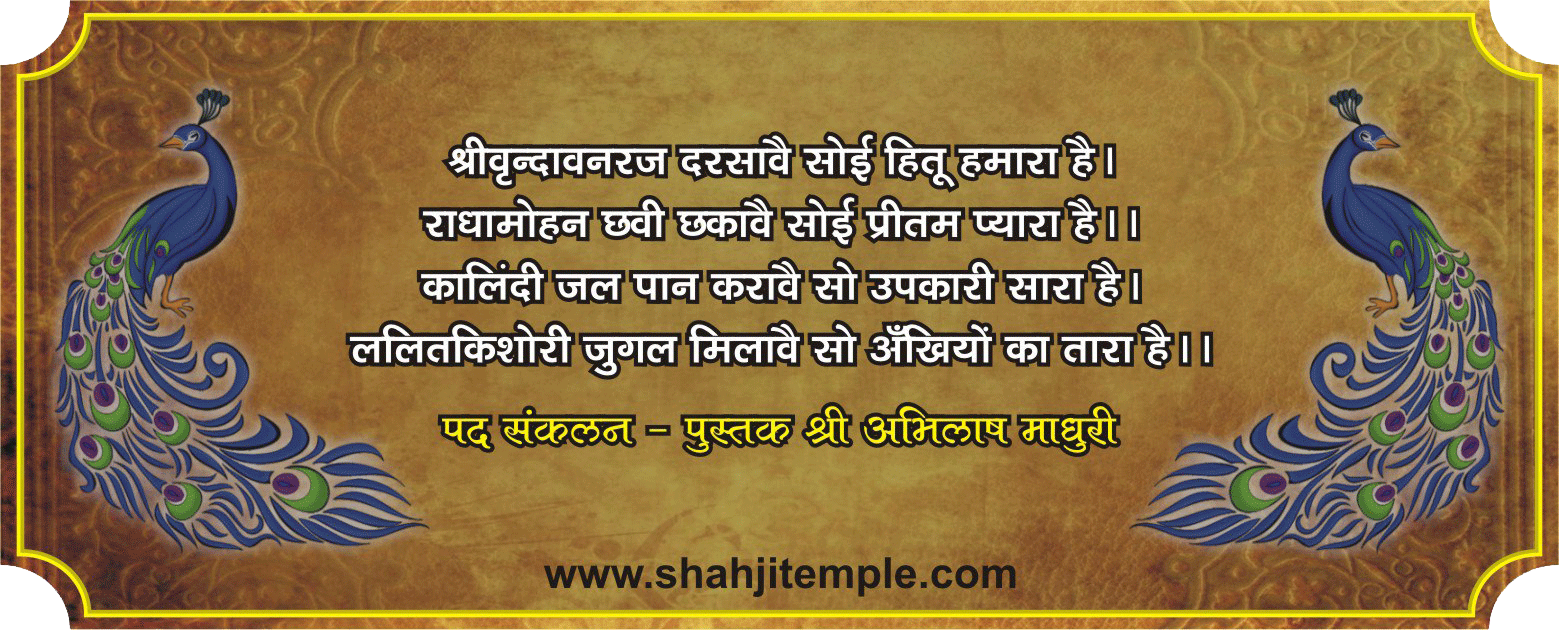

In the Right Verandah the portraits of the founders and their family have been carved on the floor. The portraits inscribed reflect the purity of their mind and the saintly character in a vividly live manner. The Idea of putting their pictures on the floor instead of the wall is an explicit mark of their saintliness. In Braj dham the 'raj' (sand) is held in the highest sanctity and glory. It is Believed that the fortunate ones who merge in the holy sand after leaving their mortal remains achieve the blessed seat known as GOLOKA or the LAND of BLISS. The portraits of the founders on the floor instead of on the wall meaningfully indicate that they would constantly receive Braj Raj as the saints and devotees pass over them on the floor barefooted to have darshan of Lord Shri Ji. This Depicts the importance of Braj Raj.
The lower portion of the sanctum sanatorium has fourteen panels of five feet in height. All of them are superb examples of pictorial inlay work in stone executed in an unconventional style. The treatment is reminiscent of the miniature style and it seems as though enlarged miniature paintings have been transcribed onto the stonewalls. These panels are unique in the history of stone inlay in more ways then one, as we shall see. The panel features female figures (gopikas) in a standing position. They may be easily termed as marble paintings or paintings on marble. Most of the female figures portrayed are of musicians, each playing a musical instrument. Dressed in the court costumes (of Lucknow), they appear to be in the Durbar of the Lord. Two panels, however, stand out as exceptional. In one a girl is engaged in Kabutarbazi, (pigeon flying), the favorite sport of feudal society in the nineteenth century and in the other, a beautiful young girl wrings out the water from her hair. Some water drops fall onto the beak of a peacock standing close by. This ancient theme dating from the period of the Mathura sculptures has been rendered with exceptional delicacy and vibrancy. Here some attempt has been made at symbolism-the young girl is Radha and the peacock stands for Krishna. It was not uncommon to depict man-woman relationship in terms of the love between Radha and Krishna. This literary tradition dates from very ancient times in which the Maithil poet Jaidev’s immortal song Gita Govinda became a major landmark. These panels clearly suggest that those persons were no ordinary inlay craftsman. The light yellow colored chandelier has a diameter of twelve feet. Besides these hanging chandeliers there are numerous wall chandeliers and also standing ones. Till 1940 there was no electricity in Vrindaban and all wax candles illuminated these chandeliers. But in the modern times it is fully equipped with electric bulbs. When all the lights are switched on the reflection from the innumerable mirrors simply manifolds and the devotees are wonderstruck with the beauty of this room. In the center of the Basanti Kamra there are three fountains. The fountains have been placed miraculously in a single piece of white marble block of 10 x 5 dimension. The block has been artistically carved and made hollow at the four corners, which are fountains, and that too in working condition.
The sanctum sanatorium is 40 X 35 feet in area. The nine chandeliers hanging down from the forty feet high dome is a beautiful sight par-excellence for the visitors and pilgrims. It is a rarely seen achievement projecting the architectural competence of the builders. The sanctum sanatorium contains several fountains, which flourish aesthetically during special festivals and occasions.Twelve life size statues adorn the upper side of the hall. Eleven of these statues display the gopikas in their different dance postures. This projects the typical Rasa-Lila of Braj wherein the maidens enjoy the ecstatic company of the Lord in his blissful play. The twelfth statue is that of Nawab Wajid Ali Shah attending to the sewa (worship) of Thakur Radha Raman ji Maharaj. Especially in the context of a Hindu temple it shows the great secular sentiments of the founders.
 |  |  |  |
|---|---|---|---|
 |  |  |  |
